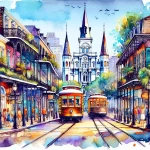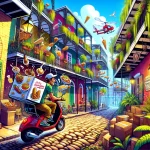Mardi Gras in New Orleans is a captivating celebration deeply rooted in the city’s unique history and diverse traditions, particularly in the iconic French Quarter. This festive occasion brings together a tapestry of influences that have shaped the city over centuries.
In This Article
TL;DR
- The French Quarter hosts the vibrant Mardi Gras parades, costumes, and the beloved King Cake tradition.
- Mardi Gras fosters a sense of community, cultural exchange, and economic growth in the historic neighborhood.
- Visitors can fully immerse themselves in the festivities while respecting local traditions and supporting the community.
The Historical Roots of Mardi Gras in New Orleans
Mardi Gras, or “Fat Tuesday,” has been celebrated in New Orleans since the city’s founding in 1718. The French Quarter, the city’s oldest neighborhood, has been at the heart of Mardi Gras celebrations since the early 1800s. In 1833, wealthy plantation owner Bernard Xavier de Marigny de Mandeville raised funds to establish an official Mardi Gras celebration, solidifying the French Quarter’s role as the epicenter of the festivities.
Signature Traditions of French Quarter Mardi Gras
Iconic Parades
The French Quarter comes alive during Mardi Gras season, with a series of iconic parades winding through its historic streets. The Krewe of Zulu, one of the oldest and most revered African American krewes, kicks off the festivities on Mardi Gras Day with their parade starting at the intersection of Jackson and Claiborne Avenues. The Rex parade, which debuted in 1872, follows closely behind, showcasing elaborate floats and the “King of Carnival” himself.
Masks and Costumes
Masks and costumes are an integral part of Mardi Gras celebrations, with revelers donning elaborate disguises to conceal their identities and embrace the spirit of revelry. The tradition of masking dates back to the early days of Mardi Gras, when laws prohibiting the concealment of one’s identity were temporarily suspended for the festivities.
The Iconic King Cake
No Mardi Gras celebration would be complete without the iconic King Cake. This ring-shaped pastry, adorned with purple, green, and gold icing (representing justice, faith, and power, respectively), is a beloved treat enjoyed throughout the Carnival season. Bakers often hide a small plastic baby figurine inside the cake, and tradition dictates that whoever finds it must host the next King Cake party or buy the next cake.
The Cultural Tapestry of Mardi Gras
Mardi Gras in New Orleans is a vibrant tapestry of cultural influences, reflecting the city’s diverse heritage. The festivities have been shaped by the traditions of French, Spanish, African, Native American, and other cultures that have called New Orleans home over the centuries.
Music and dance are integral parts of the Mardi Gras experience, with brass bands, jazz ensembles, and second-line parades filling the streets with infectious rhythms. The influence of African and Caribbean cultures is evident in the colorful costumes, intricate beadwork, and energetic dance styles that accompany the celebrations.
Mardi Gras fosters a sense of community and cultural exchange, bringing together people from all walks of life to celebrate the city’s rich heritage. The French Quarter becomes a melting pot of traditions, where locals and visitors alike can immerse themselves in the vibrant sights, sounds, and flavors of New Orleans.
Experiencing Mardi Gras: Practical Tips and Advice
To fully experience the magic of Mardi Gras in the French Quarter, timing is everything. The festivities reach their peak in the weeks leading up to Fat Tuesday, with parades and celebrations occurring daily. The French Quarter’s narrow streets and historic buildings provide prime viewing spots for the parades, but visitors should arrive early to secure a good vantage point.
Safety should be a top priority when navigating the crowds and revelry of Mardi Gras. Visitors should stay hydrated, wear comfortable shoes, and be mindful of their surroundings. It’s also advisable to travel in groups and avoid carrying valuables or wearing excessive jewelry.
For a truly immersive experience, visitors should consider attending one of the many Mardi Gras balls or masquerade parties hosted by local krewes and organizations. These events offer a glimpse into the rich traditions and pageantry of Mardi Gras, with elaborate costumes, live music, and a festive atmosphere.
Culinary Delights of Mardi Gras
Mardi Gras in New Orleans is a feast for the senses, and the French Quarter is a culinary paradise during the festivities. Traditional Mardi Gras dishes, such as gumbo, jambalaya, and beignets, are staples at local restaurants and street vendors.
King Cake, the quintessential Mardi Gras treat, can be found in bakeries and cafes throughout the French Quarter, with each establishment offering its unique twist on the classic recipe. From cream cheese-filled to praline-topped, the variations are endless, and sampling different versions is a beloved tradition among locals and visitors alike.
Food plays a central role in Mardi Gras celebrations, with community gatherings and block parties often revolving around shared meals and indulgent treats. The French Quarter’s vibrant restaurant scene offers a variety of culinary experiences, from classic Creole cuisine to innovative fusion fare, ensuring that every palate is satisfied during the festivities.
The Economic and Social Impact of Mardi Gras
Mardi Gras is not only a cultural phenomenon but also a significant economic driver for New Orleans and the French Quarter. The festivities attract millions of visitors each year, generating substantial revenue for local businesses, hotels, restaurants, and retailers.
Beyond the economic impact, Mardi Gras plays a vital role in supporting local artisans and cultural organizations. The creation of elaborate costumes, floats, and decorations provides employment opportunities for skilled craftspeople, while the proceeds from events and merchandise sales help fund community initiatives and preserve cultural traditions.
Moreover, Mardi Gras serves as a platform for social change and community development. Local organizations and krewes often use the festivities to raise awareness about important issues, promote diversity and inclusion, and foster a sense of unity and pride within the community.
Preserving Traditions and Embracing the Future
As Mardi Gras continues to evolve, efforts are underway to preserve the rich traditions and cultural heritage of the French Quarter celebrations. Local organizations and community leaders work tirelessly to educate younger generations about the significance of Mardi Gras customs and ensure their continuation for years to come.
At the same time, new generations are contributing their own unique perspectives and innovations to the festivities. Contemporary artists and designers are reimagining traditional costumes and floats, infusing them with modern aesthetics and social commentary. This fusion of tradition and innovation ensures that Mardi Gras remains a dynamic and relevant celebration, while still honoring its historical roots.
Engaging with the Community: Mardi Gras Beyond the Parades
While the parades and revelry are undoubtedly the main attractions of Mardi Gras, visitors have the opportunity to engage with the local community in meaningful ways. Volunteer opportunities abound during the Carnival season, from assisting with parade preparations to participating in neighborhood clean-up efforts after the festivities.
Visitors can also contribute to the local economy by supporting small businesses, artisans, and cultural organizations in the French Quarter. Attending community events, purchasing locally-made souvenirs, and patronizing family-owned restaurants are all ways to give back to the neighborhood that hosts the iconic Mardi Gras celebrations.
Respectful participation in Mardi Gras traditions is key to fostering a positive relationship between visitors and the local community. By embracing the spirit of the festivities while respecting cultural norms and boundaries, visitors can create lasting memories and forge connections that transcend the fleeting revelry of Carnival season.






